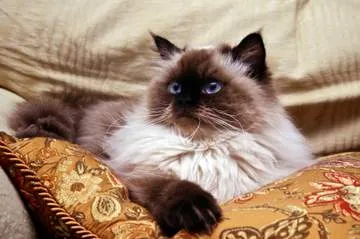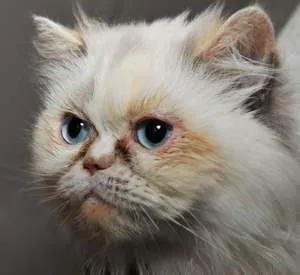Himalayan Persian cats, often affectionately called “Himmies,” are a stunning hybrid breed that combines the luxurious long coat of the Persian with the striking colorpoint patterns of the Siamese. If you’re a cat lover searching for information on seal point himalayan cat, you’ve come to the right place. These elegant felines have captured hearts worldwide with their plush fur, vivid blue eyes, and gentle demeanor, making them ideal companions for families and individuals alike.
Renowned for their unique appearance and charming personality, Himalayan Persian cats require dedicated grooming and care to thrive. Whether you’re considering adopting one or already sharing your home with a Himmy, understanding their history, traits, and needs is essential for providing the best possible life.
The Origins and Names of Himalayan Persian Cats
Himalayan Persian cats emerged from deliberate crosses between Persian and Siamese breeds in the early 20th century. Breeders first noted these Persian/Siamese hybrids in the 1920s, but it took until the 1950s to refine the desired thick coats and precise colorpoint markings. The name “Himalayan” draws from the Himalayan rabbit, which shares the same genetic factor responsible for the pointed coloration seen in Siamese cats and their relatives.
Depending on the cat registry, Himmies go by various names, including Colorpoint Persian, Colourpoint Longhair, Himalayan Siamese, or Longhair Siamese. In the United States, “Himalayan” is the most common term, while the UK’s Governing Council of the Cat Fancy recognized them as Colourpoint Longhairs in 1955. By the 1960s, major American associations followed suit with the “Colorpoint Longhair” designation. This naming confusion highlights the breed’s blended heritage but doesn’t detract from its popularity among cat enthusiasts.
These medium to large cats exhibit a stocky body type more akin to the Persian than the sleek Siamese, with weights typically ranging from 7 to 12 pounds. Their round faces, short noses, and sturdy frames contribute to their doll-like appeal.
 Seal Point Himalayan Persian cat
Seal Point Himalayan Persian cat
Himalayan Persian Cat Colors and Patterns
One of the most captivating features of Himalayan Persian cats is their colorpoint patterns, where the body remains pale (often white or cream) while darker shades concentrate on the ears, face, legs, and tail. Common varieties include seal point (deep brown points), blue point (grayish-blue), chocolate point (milk chocolate), lilac point (soft pinkish-gray), red or flame point, and cream point.
More complex patterns like tortiepoint (tortoise shell) and lynx (tabby) points add even greater variety. For instance, a seal tortie point features a mix of black and red shades on the points, creating a marbled effect. These colors are genetically linked to the temperature-sensitive Himalayan gene, which produces darker pigmentation in cooler body areas.
If you’re exploring flamepoint siamese or other pointed breeds, Himalayan Persians offer a plush alternative with their long, silky coats.
 Flame Point Himalayan Persian cat
Flame Point Himalayan Persian cat
Grooming and Daily Care for Himalayan Persians
Himalayan Persian cats inherit their Persian parent’s glorious long, dense coat, which demands consistent grooming to prevent matting. Brush daily, focusing on high-friction areas like the neck ruff, between the legs, under the tail, and around the ears. A wide-toothed comb helps remove loose fur and tangles, reducing shedding around your home.
Their flat faces, similar to flat face cat breed, lead to tear staining and eye discharge, so gently clean their faces and eyes each day with a warm, damp cloth or cotton ball soaked in saline solution. Many breeders recommend occasional baths with a cat-specific shampoo to maintain coat shine, followed by thorough drying to avoid chills. Regular nail trims and dental care round out their routine.
Veterinarians emphasize starting grooming early to acclimate kittens, drawing from guidelines by the Cat Fanciers’ Association (CFA) and The International Cat Association (TICA).
Health, Personality, and Lifespan of Himmies
Generally robust due to Siamese influences, Himalayan Persian cats can inherit Persian-related issues like polycystic kidney disease (PKD), a genetic condition affecting the kidneys. Responsible breeders screen for PKD via ultrasounds, as recommended by veterinary experts. Other concerns include respiratory issues from brachycephalic (flat-faced) features and hypertrophic cardiomyopathy (HCM), though incidences are lower than in pure Persians.
Himmies boast a lifespan of 12-15 years with proper care. Their temperament blends Persian calmness with Siamese sociability—they’re intelligent, affectionate, and moderately active, often forming strong bonds with owners. Unlike more aloof Persians, they enjoy playtime and vocalize softly, making them great for households with children or other pets.
 Tortie Point Himalayan Persian cat
Tortie Point Himalayan Persian cat
These cats thrive in indoor environments, away from drafts, with a high-quality diet rich in protein to support their coat health. Consult a vet for personalized nutrition plans, especially for weight management.
For broader insights into feline varieties, check out our guides on grey cat breeds and all kinds of cats.
Final Thoughts on Owning a Himalayan Persian Cat
Himalayan Persian cats embody elegance and companionship, blending the best traits of two iconic breeds. From their myriad colorpoints to their grooming needs and loving nature, Himmies require commitment but reward owners with unwavering loyalty. Prioritize health screenings from reputable breeders and schedule annual vet check-ups to ensure a long, happy life.
Ready to welcome a Himmy into your home? Share your experiences in the comments or explore more cat breed articles for expert tips on pet care.
References:
- Cat Fanciers’ Association (CFA): Breed Standards for Himalayan.
- The International Cat Association (TICA): Himalayan Persian Health Guidelines.
- Winn Feline Foundation: Polycystic Kidney Disease in Cats.
